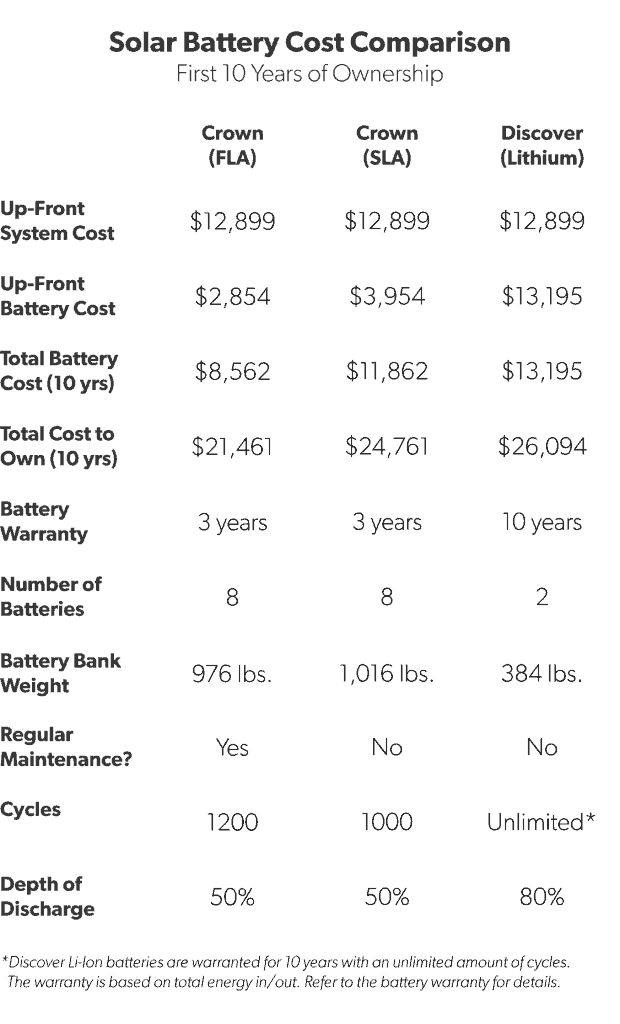Lead-acid vs. Lithium Battery Comparison
Lead-acid batteries cost less up front, but they have a shorter lifespan and require regular maintenance to keep them running properly. Lithium batteries are much more expensive up front, but they are maintenance-free and have a longer lifespan to match their higher price tag. This article offers a side-by-side comparison of both options.
Welcome to our Solar 101 series! This article goes over a choice you’ll need to make if you buy a battery-based solar system, either to move off the grid or to add energy storage to your grid-connected home.
Specifically, we’re going to look at lead-acid vs. lithium-ion batteries — the two main battery types used for solar. Here’s the summary:
Lead-acid is a tried-and-true technology that costs less, but requires regular maintenance and doesn’t last as long.
Lithium is a premium battery technology with a longer lifespan and higher efficiency, but you’ll pay more money for the boost in performance.
Let’s go over the pros and cons of each option in more detail, and explain why you might choose one over the other for your system.
Lead-acid vs. Lithium Solar Batteries: The Basics
When you build a solar system, you have three main battery options:
Flooded Lead-Acid (FLA)
The distinguishing feature of FLA batteries is that the plates are submerged in water. These must be checked regularly and refilled every 1-3 months to keep them working properly.
Falling behind on upkeep can shorten the life of the batteries and void the warranty. FLA batteries also need to be installed in a ventilated enclosure to allow battery gases to escape.
Sealed Lead-Acid (SLA)
SLA batteries come in two types, AGM (Absorbent Glass Mat) and Gel, which have many similar properties. They require little to no maintenance and are spill-proof.
The key difference in AGM vs. gel batteries is that gel batteries tend to have lower charge rates and output. Gel batteries generally can’t handle as much charge current, which means they take longer to recharge and output less power.
Lithium
The best lithium battery chemistry for solar applications is Lithium Iron Phosphate, shorted to LiFePO4 or LFP batteries. This new technology lasts longer and can be put through deeper cycles. They also require no maintenance or venting, unlike lead-acid batteries.
Lithium batteries cost more up front, but the extra efficiency means you can potentially spend less per kilowatt-hour of capacity over the lifespan of the battery.
Lead-acid vs. Lithium Batteries: Pricing Breakdown
Let’s look at how much it would cost to build a battery bank with all three options.
We’re not just interested in the up-front cost, but also the cost of ownership over the life of the system. As an example, we’ll look at how much the batteries would cost to power this 5.13 kW off-grid system, which we sell for $12,899 at the time of publication.
In an off-grid environment, you want to look at the estimated cycle life since you are cycling your batteries on a daily basis. This system would produce an estimated 23.08 kWh per day in the summer and 11.54 kWh per day in the winter.
Here’s how much it would cost to buy batteries for that system over the first 10 years. We are comparing the following battery banks:
- 8 Crown CR430 FLA batteries
- 8 Crown 6CRV390 SLA AGM batteries
- 2 Discover AES Lithium 6.6 kWh batteries

A Few Notes About This Chart
We are estimating that the lead-acid batteries will be replaced 3 times over a 10 year period, the lifespan of 1 lithium battery. This comparison is based on the length of the warranty offered by the manufacturers.
We’ve done our best to give an apples-to-apples comparison of these batteries based on their printed specs. However, in real-world applications, factors like discharge depth, temperature, charging source, overall system design, and your willingness to perform regular maintenance will affect the true performance of your batteries.
5 Key Differences Between Lead-acid and Lithium Batteries
1. Cycle life
When you discharge a battery (use it to power your appliances), then charge it back up with your panels, that is referred to as one charge cycle. We measure the lifespan of batteries not in terms of years, but rather how many cycles they can handle before they expire.
Think of it like putting mileage on a car. When you evaluate the condition of a used car, mileage matters a lot more than the year it was produced.
Same goes for batteries and the number of times they’ve been cycled. A sealed lead-acid battery at a vacation home may go through 100 cycles in 4 years, whereas the same battery might go through 300+ cycles in one year at a full-time residence. The one that has gone through 100 cycles is in much better shape.
Cycle life is also a function of depth of discharge (how much capacity you use before recharging a battery). Deeper discharges put more stress on the battery, which shortens its cycle life.
2. Depth of Discharge
Discharge depth refers to how much overall capacity is used before recharging the battery. For example, if you use a quarter of your battery’s capacity, the depth of discharge would be 25%.
Batteries don’t discharge fully when you use them. Instead, they have a recommended depth of discharge: how much can be used before they should be refilled.
Lead-acid batteries should only be run to 50% depth of discharge. Beyond that point, you risk negatively affecting their lifespan.
In contrast, lithium batteries can handle deep discharges of 80% or more. This essentially means they feature a higher usable capacity.
3. Efficiency
Lithium batteries are more efficient. This means that more of your solar power is stored and used.
As an example, lead acid batteries are only 80-85% efficient depending on the model and condition. That means if you have 1,000 watts of solar coming into the batteries, there are only 800-850 watts available after the charging and discharging process.
Lithium batteries are more than 95% efficient. In the same example, you’d have over 950 watts of power available.
Higher efficiency means your batteries charge faster. Depending on the configuration of your system, it could also mean you buying fewer solar panels, less battery capacity and a smaller backup generator.
4. Charge Rate
With higher efficiency also comes a faster rate of charge for lithium batteries. They can handle a higher amperage from the charger, which means they can be refilled much faster than lead-acid.
We express charge rate as a fraction, such as C/5, where C = the capacity of the battery in amp hours (Ah). So a 430 Ah battery charging at a rate of C/5 would receive 86 charging amps (430/5).
Lead-acid batteries are limited in how much charge current they can handle, mainly because they will overheat if you charge them too quickly. In addition, the charge rate gets significantly slower as you approach full capacity.
Lead acid batteries can charge around C/5 during the bulk phase (up to 85% capacity). After that, the battery charger automatically slows down to top off the batteries. This means lead acid batteries take longer to charge, in some cases more than 2x as long as a Lithium alternative.
5. Energy Density
The lead-acid batteries featured in the comparison above both weigh around 125 pounds. The lithium battery checks in at 192 pounds.
Most installers can handle the extra weight, but DIYers might find the lithium batteries more challenging to install. It’s wise to enlist some help lifting and moving them into place.
But that comes with a tradeoff: the energy density of lithium batteries is much higher than lead-acid, meaning they fit more storage capacity into less space.
As you can see in the example, it takes two lithium batteries to power a 5.13 kW system, but you’d need 8 lead-acid batteries to do the same job. When you take the size of the entire battery bank into account, lithium weighs less than half as much.
This can be a real benefit if you need to get creative with how you mount your battery bank. If you are hanging an enclosure on the wall or hiding it in a closet, the improved energy density helps your lithium battery bank fit into tighter spaces.
Lithium vs. Lead-Acid: Which Should You Choose?
Lithium and lead-acid grade out at comparable prices over the life of ownership, but lithium is a much steeper investment up front. We wouldn’t recommend it unless you use your system on a daily basis.
Here are the battery types we’d recommend for a variety of applications:
Full-Time Off-Grid Residence
Flooded Lead-Acid or Lithium.
If you live off the grid full-time, your best bet is FLA (if you don’t mind regular maintenance) or the premium Lithium option for heavy use.
Off-Grid Cabin / Vacation Home
Sealed Lead-Acid.
If you own something like a hunting cabin or a vacation home, you’ll only be there a few times a year. That means you won’t be able to keep up with the maintenance required of FLA batteries.
Spend a bit extra on SLA instead. They’re zero-maintenance, so they won’t die if they sit idle for a few months.
Battery Backup System
Sealed Lead-Acid.
Let’s say you are building a system with battery backup for emergency power outages. Ideally, you will only use those batteries once a year (a few times if you live in an area with an unreliable power grid). They won’t see enough use for you to invest into lithium, and you don’t want to perform maintenance on FLA batteries you use once a year.
Go with SLA, which (again) don’t require upkeep.
Remote Industrial Use
Sealed lead-acid or lithium.
The decision-making process is pretty much the same here. Lithium could be worth it to power an industrial site that sees heavy use. If you are powering basic monitoring equipment at a remote outpost, SLA will get the job done cheaper, and you still won’t have to worry about maintenance visits.





